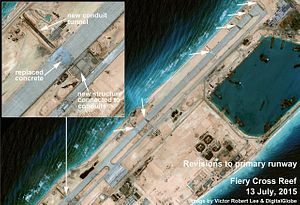On January 2, China conducted the first-ever landing on the new airstrip on Fiery Cross Reef in the South China Sea, drawing diplomatic protests from Vietnam and the Philippines. In the days since then, Chinese officials have been justifying Beijing’s decision to construct the new airstrip in the disputed Spratly Islands, to which Brunei, Malaysia, the Philippines, Taiwan, and Vietnam also having varying claims.
At over 3,000 meters long, the runway at Fiery Cross Reef is large enough to be used by any Chinese military aircraft, from long-range bombers to fighter jets. According to the Asia Maritime Transparency Initiative, similarly sized airstrips are believed to be under construction at Subi Reef and Mischief Reef. Four of the other five rival claimants (Malaysia, the Philippines, Taiwan, and Vietnam) also have airstrips in the Spratly Islands, but the Fiery Cross airstrip is over twice as long as the next largest (Malaysia’s 1,300 meter airstrip at Swallow Reef) and is the only one capable of accommodating bombers.
Despite the clear military applications of China’s new runway(s) in the South China Sea, Beijing has been insistent that the primary purpose of its new facilities is civilian. Since the first detailed official explanation for the construction was provided in April 2015, Chinese officials have consistently claimed that the new facilities will be used to provide civilian services, including maritime search and rescue, navigation aid, marine research, and even weather observation.
The landing on January 2 was pointedly conducted by a civilian aircraft; according to Chinese Foreign Ministry spokesperson Hua Chunying, the purpose was to “test whether or not the facilities on it meet the standards for civil aviation.” Hua added that the test flight “falls completely within China’s sovereignty,” as “China has indisputable sovereignty over the Nansha Islands and their adjacent waters” (Nansha is the Chinese term for the Spratlys).
On Tuesday, another Chinese official similarly emphasized the civilian uses for the new airstrip. Pan Wei, chief engineer of China Rescue and Salvage in the Ministry of Transport, said that China’s new facilities will help ensure safety for airplanes and ships in the South China Sea. “The severe shortage of navigation safety facilities, emergency rescue forces, and equipment to deal with oil spills in the South China Sea has impeded the navigation security and economic and social development in the area,” Pan said, as quoted by Xinhua.
Pan said new lighthouses constructed by China as well as the airstrip at Fiery Cross Reef would help improve navigation safety. The concern for other claimants, as well as the United States, however, is that ‘improving navigation safety’ is China’s code for preventing foreign vessels from transiting through international waters near Chinese-held features. Already, regional militaries have reported an increase in the number of times China has warned aircraft to move away from disputed areas, Reuters notes. Such incidents are expected to increase as China’s complete construction on other facilities.
Meanwhile, Pan made no attempt to hide the fact that one driving factor behind the construction was the need to increase China’s capabilities in the Spratlys, which are over 400 miles from the Chinese mainland. Again, he framed this in terms of civilian uses, saying the airstrip would provide more immediate responses to shipwrecks, natural disasters, or pirate activities. Pan pointed to the search for missing Malaysia Airlines flight MH 370 in 2014 as evidence that insufficient facilities were hampering emergency response efforts in the South China Sea.
However, here again there are obvious military applications for increasing China’s presence in the South China Sea and its ability to respond immediately to any incidents (whether search-and-rescue operations, as Pan indicated, or flare-ups around disputed features). Taking the need for a faster response time to its logical conclusion, China would need to permanently station aircraft on Fiery Cross, which Ian Storey of Singapore’s Institute of Southeast Asian Studies believes is likely to happen.
In November 2015, one Chinese official went farther in acknowledging the military applications of the construction. On the sidelines of the ASEAN meetings in Kuala Lumpur, Chinese Vice Foreign Minister Liu Zhenmin argued that “to build necessary military defense facilities on islands far away from our mainland is required by the need both of national defense and of safeguarding our islands and reefs.” Liu added that China’s construction of those military facilities “should not be mistaken for actions to militarize the South China Sea.”

































